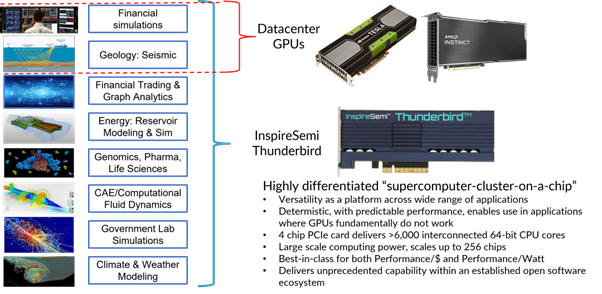InspireSemi’s Thunderbird I RISC-V chip offers high-performance computing for underserved applications, with an emphasis on energy efficiency and competitive pricing. It targets HPC tasks like graph analytics and features 24 TFLOPS of raw performance, 50 GFLOPS per watt energy efficiency, and reduced latency. Delivery to customers is expected in the fourth quarter.

What do we think? There’s a bit of a trend towards more general-purpose processors at the moment. Intel’s post-Gaudi road map is headed that way, and AMD is a little ahead of them. InspireSemi has a massive core approach, similar to Esperanto Technologies. With a potential four chips per card, you can have up to 6,144 cores per card and up to 360,000 cores at the cluster level. Workload management will be a challenge, but that’s the case for most HPC systems.
The market fit is interesting. This product targets underserved and diversified industries, including financial services, computer-aided engineering, and energy, rather than going head-to-head with Nvidia on GenAI.
Use of the open-standard RISC-V instruction set architecture is being sold as a route to software compatibility. We’ve yet to see much evidence of that much-made claim, but we are open-minded.
RISC-V for HPC
Austin, Texas-based InspireSemi is making accelerated computing solutions for high-performance computing (HPC), AI, graph analytics, and other compute-intensive workloads, and has announced the tape-out of its Thunderbird I accelerated computing chip for fabrication at TSMC (plus ASE for packaging).
Ron Van Dell, CEO of InspireSemi, said, “We expect to begin customer deliveries in the fourth quarter.”
Thunderbird I is a system on a chip (SoC) featuring 1,536 custom 64-bit RISC-V CPU cores, integrated with high-speed memory and low-latency networking. This chip is designed to deliver high performance, energy efficiency, and a competitive price for various applications, leveraging the RISC-V CPU software ecosystem.
InspireSemi says compared to GPUs, Thunderbird provides extensive computational power suitable for HPC applications, including graph analytics for fraud detection, anti-money laundering, anti-terrorism, pharma trials, and supply chain management.
The initial product will be a PCIe add-in card with four Thunderbird devices, offering over 6,000 CPU cores and support for double-precision math, essential for many HPC tasks.
Claimed performance is:
- Raw performance: 24 TFLOPS (FP64)
- Energy efficiency: 50 GFLOPS/watt (FP64)
- Utilization: network reduces latency 20×
Alex Gray, founder, CTO, and president of InspireSemi, said, “Thunderbird accelerates many critical applications in important industries that other approaches do not, including life sciences, genomics, medical devices, climate change research, and applications that require deep simulation and modeling.”